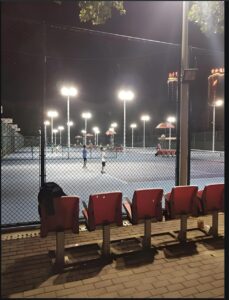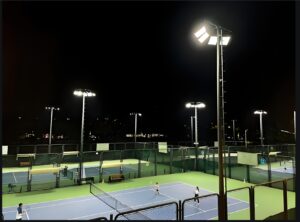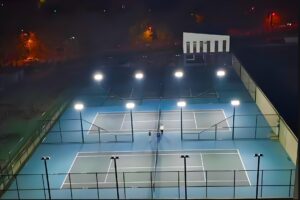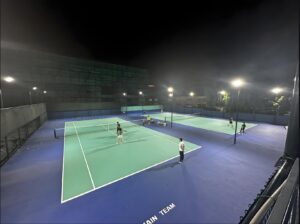The minimum lux standards established by the ITF for professional tennis matches—ranging from 1000 lux to 1500 lux depending on the specific lighting needs—ensure that players can see the ball clearly, minimizing the risk of missed shots or discomfort. These guidelines emphasize the importance of uniformity, glare control, and consistency in lighting design, all of which contribute to a comfortable and efficient playing environment. Additionally, LED lighting systems are an excellent choice for meeting these standards, offering energy efficiency, long-term durability, and the flexibility to adapt to different match conditions. By adhering to these standards, tennis venues can guarantee that both players and viewers enjoy an optimal experience throughout each match.

Professional tennis events, particularly high-profile tournaments like Wimbledon, have stringent lighting standards to ensure the best playing conditions for athletes and a high-quality viewing experience for fans. The lighting must be consistent, glare-free, and of an intensity that supports quick reflexes, especially in high-speed sports like tennis. In recent years, LED lighting systems have become the preferred solution due to their ability to meet these demands while offering several advantages over traditional lighting technologies. Here’s an overview of how LED systems are designed to meet the lighting requirements for professional events like Wimbledon.
As mentioned in the ITF guidelines, professional tennis matches require 1000 lux as the minimum lighting level across the entire court, with 1500 lux often required for televised events. Wimbledon, being one of the most prestigious tennis tournaments, adheres to these lux standards to ensure optimal visibility.
LED systems are engineered to provide highly consistent light levels with precise control over light output, allowing them to meet or exceed these lux standards. The lux output of an LED system can be adjusted and fine-tuned for the specific needs of each match. For instance, higher lux levels can be achieved during evening sessions or televised events to ensure optimal ball visibility on camera and reduce the potential for shadows or dim areas on the court.
One of the critical aspects of meeting professional standards is the uniformity of the lighting. The ITF requires that the lighting system provide a uniform distribution of light across the court, avoiding any shadows or hot spots. The uniformity ratio, which compares the brightest to the darkest areas of the court, must be at least 0.7 for a consistent lighting experience.
LED systems are ideal for this application due to their directivity and precision. LEDs emit light in a focused direction, which can be controlled with specific optics and diffusers to ensure that light is distributed evenly across the entire playing surface. The ability to design LED lighting systems with multiple individual fixtures that can be aimed precisely at specific areas of the court helps achieve this uniform lighting across the entire venue.
One of the most significant advantages of LED lighting is the ability to adjust both brightness and color temperature in real time. For tournaments like Wimbledon, where lighting conditions may change from day to night, LED systems offer dynamic control to adapt to these shifts.
This flexibility ensures that lighting conditions remain consistent throughout the tournament, regardless of the time of day or environmental conditions.
Professional tennis tournaments like Wimbledon not only require high-quality lighting, but they also demand energy-efficient solutions due to the significant operational costs involved. LED systems are known for their low energy consumption, and this is a key reason why they are the preferred option for events like Wimbledon.
LEDs consume significantly less energy compared to traditional HID (high-intensity discharge) or metal halide lamps, which were previously used in sports venues. By using LED lights, Wimbledon and other professional events can achieve the required lighting levels while significantly reducing the overall power consumption, making the event more sustainable.
Another advantage of LEDs is their long lifespan. Unlike traditional lighting systems that require frequent replacements, LED systems can last up to 50,000 hours or more, making them ideal for high-use environments like professional tennis venues. This longevity means that maintenance costs are lower, and the venue does not have to worry about downtime during a tournament.
The long lifespan of LED systems also means fewer replacements are required, which reduces the amount of waste generated by the lighting system, contributing to Wimbledon’s overall sustainability goals.
In professional tennis, controlling glare is essential to maintain player focus and comfort. Too much direct light in a player’s eyes can be distracting and affect their performance. Moreover, glare in the eyes of viewers, whether they are in the stadium or watching from home, can negatively impact the viewing experience.
LED systems designed for tennis venues like Wimbledon are equipped with specific optical components, such as diffusers and baffles, to reduce glare. These components ensure that the light is directed precisely at the court, without spilling into the player’s line of sight or the viewer’s eyes. The lighting fixtures are mounted at an angle and are often equipped with shields that minimize stray light and enhance the overall comfort of both players and spectators.
One of the primary concerns for televised tennis events is flicker. Flickering lights can cause visual disruptions during broadcasts, leading to a poor viewing experience. Professional events like Wimbledon rely on flicker-free lighting to ensure that the image captured on camera is stable and clear.
LED systems designed for such events are built with advanced drivers and power supplies that prevent flickering, even under rapid camera movement or high-speed play. These systems are capable of providing a stable light output with no visible flicker, which is essential for high-quality broadcasts, where even the slightest irregularity can negatively impact the viewing experience.
LED systems are designed with precise beam angles and optics that allow for focused, directional lighting. This ensures that the lighting is evenly spread across the court without spilling onto surrounding areas. This feature is especially important in tennis venues, where the playing area is typically surrounded by empty space or seating areas.
For high-profile events like Wimbledon, multiple LED fixtures are strategically placed around the court to provide targeted illumination. The ability to control the direction of the light helps ensure that the playing surface is uniformly lit, with no part of the court being over-illuminated or under-illuminated.
In addition to meeting the lighting requirements during actual match play, LED systems are also designed to handle different lighting levels during warm-up or post-match activities. Before a match, players may need brighter light levels for warming up, and after the match, the lighting can be adjusted to create a more relaxed atmosphere for interviews or post-match ceremonies.
LED systems can be quickly adjusted to meet these needs, allowing for smooth transitions between different lighting conditions throughout the event.
LED lighting systems are increasingly becoming the standard for professional tennis tournaments like Wimbledon, as they provide the perfect balance of high-quality lighting, energy efficiency, and long-term durability. These systems are engineered to meet the demanding requirements of professional tennis, including meeting minimum lux levels, ensuring uniform illumination, offering glare reduction, and supporting broadcast quality. The flexibility of LED technology allows for precise control over light intensity, direction, and color temperature, enhancing both player performance and the spectator experience. Furthermore, the energy efficiency and longevity of LEDs contribute to reduced operational costs and sustainability efforts, making them an ideal choice for world-class events like Wimbledon.
In professional tennis, glare is one of the most significant challenges when it comes to lighting. Glare can negatively affect both player performance and the spectator experience, particularly in high-profile events like Wimbledon, where every detail is scrutinized. Glare occurs when bright light shines into the eyes of players or viewers, leading to discomfort, visual distortion, and difficulty in tracking the ball. To ensure optimal lighting conditions on the court, it is essential to minimize glare, providing a comfortable and effective environment for both athletes and spectators. LED lighting systems have proven to be highly effective in addressing glare, and here’s how they achieve that.
Glare in tennis can occur for several reasons:
LED lighting technology offers several solutions to these challenges, minimizing glare for players and spectators alike:
One of the key benefits of LED lights is their directionality. Unlike traditional lighting sources like metal halide or HID lights, which scatter light in all directions, LEDs emit light in a highly controlled beam. This means that LEDs can be precisely aimed at specific areas of the court, ensuring that the light is directed exactly where it is needed without spilling into the players’ line of sight or the spectators’ eyes.
LED systems can be designed with a range of optical components, such as lenses and diffusers, that control the spread of light. This level of customization helps achieve uniform illumination across the court and minimizes the formation of bright spots and shadows.
To further minimize glare, many LED systems are equipped with glare shields or light shields that direct the light towards the playing surface, blocking excess light that could potentially reach players’ eyes. These shields act as barriers to prevent light from spilling in undesirable directions.
(To Be Continued)
Get in touch for free lighting customization